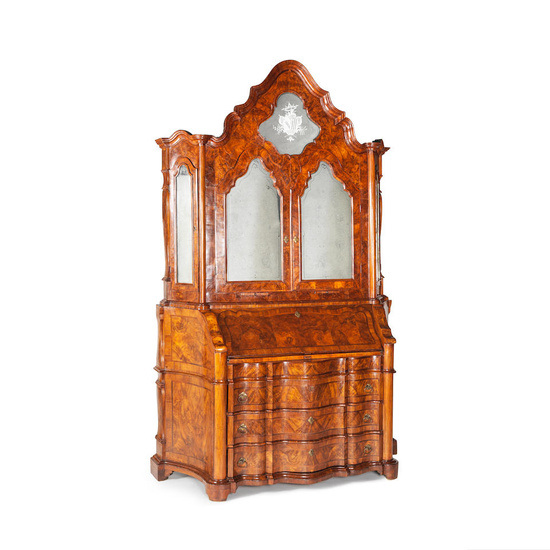Important meuble à deux corps Italien en noyer, ronce de...
A Roman Private Collection
Important meuble à deux corps Italien en noyer, ronce de noyer et filets de bois fruitier, miroir gravé à armoiries, ouvrant à deux portes, un abattant et trois tiroirs, milieu du XVIIIe siècle, probablement Venise ou Rome
An important Italian walnut, burr-walnut, fruitwood-lined and mirrored armorial bureau cabinet, mid-18th century, probably Venice or Rome
The upper section with moulded shaped pediment with a mirrored engraved coat-of-arms, above two shaped mirrored doors with engraved banding surround, the interior concealing a central door flanked by various open compartments and pigeon holes, four small drawers and two sliding candle holders, the angled sides with further mirrored doors enclosing two shelves, the inside of the doors painted in red, the lower section with a fall-front concealing a central door flanked by two pigeon holes above two small drawers and a well, and on three arc-en-arbalète long drawers, concave fronted sides and bracket feet, 168cm wide x 66cm deep x 266cm high, (66in wide x 25 1/2in deep x 104 1/2in high)
This type of majestic bureau-cabinet often called trumò in Italian were among the most showy pieces of furniture produced in the 18th century Italy. Venice and Veneto soon became the centre for the production of such masterpieces where the patrons could opt for luxurious extras as carved and giltwood ornaments to embellish to cresting, luxurious finials, and particularly beautifully engraved mirrored plates which could enrich these monuments to please noble and wealthy families. The engraved mirrors could depict genre scenes or as in this case reflect the coat-of-arms of their owners. It is probable that in this precise case, the coat-of-arms could be that of the Carafa or Carafa della Spina family. Pier Luigi Carafa (1677-1755) was a Cardinal from Neapolitan origin.
Apart from Venice, Rome was equally known centre as a production centre for this type of large scale ceremonial furniture, and the shaped uprights of the sides of the present bureau-cabinet are quite reminiscent of the Roman cabinet making production of the second quarter of the 18th century.
Sale price
Estimate
Time, Location
Auction House
A Roman Private Collection
Important meuble à deux corps Italien en noyer, ronce de noyer et filets de bois fruitier, miroir gravé à armoiries, ouvrant à deux portes, un abattant et trois tiroirs, milieu du XVIIIe siècle, probablement Venise ou Rome
An important Italian walnut, burr-walnut, fruitwood-lined and mirrored armorial bureau cabinet, mid-18th century, probably Venice or Rome
The upper section with moulded shaped pediment with a mirrored engraved coat-of-arms, above two shaped mirrored doors with engraved banding surround, the interior concealing a central door flanked by various open compartments and pigeon holes, four small drawers and two sliding candle holders, the angled sides with further mirrored doors enclosing two shelves, the inside of the doors painted in red, the lower section with a fall-front concealing a central door flanked by two pigeon holes above two small drawers and a well, and on three arc-en-arbalète long drawers, concave fronted sides and bracket feet, 168cm wide x 66cm deep x 266cm high, (66in wide x 25 1/2in deep x 104 1/2in high)
This type of majestic bureau-cabinet often called trumò in Italian were among the most showy pieces of furniture produced in the 18th century Italy. Venice and Veneto soon became the centre for the production of such masterpieces where the patrons could opt for luxurious extras as carved and giltwood ornaments to embellish to cresting, luxurious finials, and particularly beautifully engraved mirrored plates which could enrich these monuments to please noble and wealthy families. The engraved mirrors could depict genre scenes or as in this case reflect the coat-of-arms of their owners. It is probable that in this precise case, the coat-of-arms could be that of the Carafa or Carafa della Spina family. Pier Luigi Carafa (1677-1755) was a Cardinal from Neapolitan origin.
Apart from Venice, Rome was equally known centre as a production centre for this type of large scale ceremonial furniture, and the shaped uprights of the sides of the present bureau-cabinet are quite reminiscent of the Roman cabinet making production of the second quarter of the 18th century.



